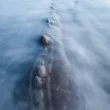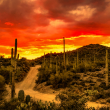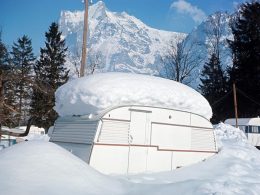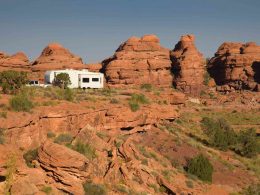The RV industry has grown over the last decade. Campgrounds have crowds, people must make reservations months in advance, and RV repair shops have bookings for weeks. One way to deal with the growing interest in RVing is by venturing out to more remote locations and dry camping. But if you do this, ensure you prepare.
Let’s look at three mistakes you don’t want to make on your weekend adventure!

What Is Dry Camping?
Dry camping is camping without external sources like electricity, water, or sewer hookups. RVs must be fully self-contained to dry camp. Holding tanks store the wastewater, and a fresh water tank provides clean water for washing, cooking, and drinking.
RVs need solar panels and batteries or a generator to provide electricity. There is no electricity pedestal, water spigot, or sewer connection when dry camping.
Are Dry Camping and Boondocking the Same?
Although people often use these terms interchangeably, dry camping and boondocking are slightly different. RVers dry camp when they boondock, but they don’t always boondock when they dry camp.
For example, you can make a reservation at a National Park campground that doesn’t offer hookups. This would be dry camping. However, it would not be boondocking. People boondock on public lands away from campgrounds.
If you pull off Highway 396 in California and park on the public land at Volcanic Tablelands, you would be dry camping and boondocking.
HOT TIP
Always get the perfect camping spot by using this guide on How To Find The Best Boondocking Spots.

What Are the Best Types of Places to Go Dry Camping?
Dry camping can happen anywhere. You can dry camp in your best friend’s driveway. However, some of the best places to go dry camping include the Bureau of Land Management (BLM) public lands, local city and county parks, state parks, and National Parks. These areas are generally less crowded than campgrounds or RV parks and offer beautiful scenery.
For example, if you want to visit the Badlands in South Dakota, one of the most popular areas for dispersed camping is Nomad View off Highway 240. RVers often see bighorn sheep, marvelous sunsets, and unobstructed views of the Badlands. The U.S. Forest Service manages the land, and it is free for dry camping.
Other places that require reservations, like state parks and National Parks, are excellent dry camping locations as well because they bring you as close as possible to the park attractions, trailheads, and amenities.
Mammoth Campground in Yellowstone National Park requires reservations and has a $25 nightly fee. There are no hookups, but access to the National Park is much easier than staying at a campground with hookups outside the park.
HOT TIP
Get the inside scoop on Is Boondocking Getting More Dangerous With the Rise of RV Living?
What Is Needed for Dry Camping?
To dry camp, your RV needs to be fully self-contained. You must provide your water and electricity and have holding tanks to catch your wastewater. Usually, this requires more than the standard features that come with an RV from the manufacturer.
RVers who want to dry camp for days or weeks usually invest in a more extensive solar power system. The solar power system typically includes multiple solar panels, a converter, and lithium batteries. The standard lead-acid battery from the manufacturer may see you through an overnight stay but not much else.
RVers who dry camp at length will also purchase a water bladder and portable tank to dump their wastewater. The water bladder makes it easier to refill the fresh tank when it runs out.
You can drive to replenish the potable water in the bladder and then return to your RV to fill the tank. The portable waste tank makes it easy to empty the black and gray tanks and go to a dump station without taking your entire RV.
3 Major Mistakes to Avoid When Dry Camping
If you’re new to the dry camping lifestyle, here are three mistakes you don’t want to make as you head out on your adventure. If you avoid these mistakes, your weekend camping trip or the week-long journey will be much more enjoyable.
1. Not Testing Your Equipment
If you haven’t been dry camping in a while (or ever), it’s crucial to test all your equipment. Make sure to charge the batteries fully. Check that the connections between the solar panels and converter all work correctly. Ensure the water pump operates well. Otherwise, you’ll be without power and water, making dry camping challenging and uncomfortable.
2. Forgetting to Look at the Weather Forecast
Any RV travel should include looking at the weather forecast. Dry campers should note the conditions before heading out. You don’t want to drive in high-wind situations or areas with tornado threats. But for dry campers, the weather can significantly affect the overall experience.
Have enough heat or cooling systems depending on the temperature. Load up on propane, especially if it is below freezing. Consider how much energy you’ll use running the air conditioner in summer temperatures with high humidity. You can bundle your solar power system with a generator if you see that the weather will be very hot or cold.
3. Not Conserving Water
Besides conserving power, the hardest thing for many dry campers is water conservation. You can’t take long showers. Sometimes it’s best not to shower at all. You can’t let the water run while you brush your teeth or wash dishes.
Take steps to ensure that you’ll have enough water during your stay. You can also invest in a water bladder that you can refill as necessary. This takes away time from camping, but it also adds comfort if you need access to more fresh water.

Is Dry Camping Worth It?
If you want to avoid the crowds and tight campsites of many campgrounds and RV parks across the country, dry camping might be the answer. The initial setup can be costly.
However, it’s worth it to experience the freedom of parking almost anywhere without worrying about full hookups. The spectacular scenery in places like Southern California, Utah, and Wyoming are perfect places to escape the day-to-day stresses of life.
The next time you’re planning a weekend camping trip, will it be dry camping on BLM land?
If You Love RVing, You Need to Stay Informed
Don’t rely on biased RV industry news sources to keep you informed with RVing news.
Stick with Nomadic News. We publish daily articles and breaking stories that matter to your RV lifestyle.










